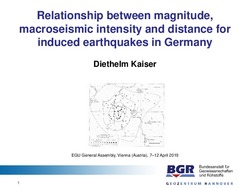Relationship between magnitude, macroseismic intensity and distance for induced earthquakes in Germany
2019Konferenzbeitrag
Englisch
Kaiser, Diethelm, 2019: Relationship between magnitude, macroseismic intensity and distance for induced earthquakes in Germany. DOI: 10.23689/fidgeo-3874.
 |
Dokument öffnen: |
Induced earthquakes are of public concern and of legal significance if they are felt or if they cause damage. Models to describe the relation between macroseismic intensities, magnitude, and distance from the epicenter or hypocenter are therefore of fundamental importance. With the aim of developing such models for induced earthquakes in Germany, the following data were analyzed:
The earthquake database for Germany GERSEIS contains parameters for ~180 induced seismic events with information on magnitude M and intensity I, of which 47 include information on mean isoseismal radii. In addition, the published macroseismic maps of seismic events in mining areas in Germany were evaluated. In Germany, earthquakes caused by mining with moderate to severe building damage (intensity 7 and 8) have so far only occurred in potash and salt mining. Slight building damage (intensity 6) has also been caused by seismic events in coal mining. Over the past 20 years, the frequency of felt earthquakes has increased in regions with natural gas production and in recent years also in regions of deep geothermal energy production.
Focal depths show a large influence on the relationship between M and I. Intensity 5 has been observed for shallow (~1 km depth) events with magnitudes as small as ML=1.8.
Simple models of the form I = a + b M + c log R, with R = hypocentral distance, can be fitted to the observations. Models for tectonic earthquakes do not fit for induced earthquakes; for induced earthquakes I is smaller for a given M and R.
Major differences were found between different mining areas: In natural gas production areas intensity 5 effects were observed at greater hypocentral distances for a given magnitude, compared to coal and potash mining areas.
Since macroseismic data (especially intensity data points) in Germany are available almost exclusively in analog form and are often difficult to access, it is necessary to establish a database for induced earthquakes with macroseismic data.
Statistik:
ZugriffsstatistikSammlung:
 CC BY 4.0
CC BY 4.0

